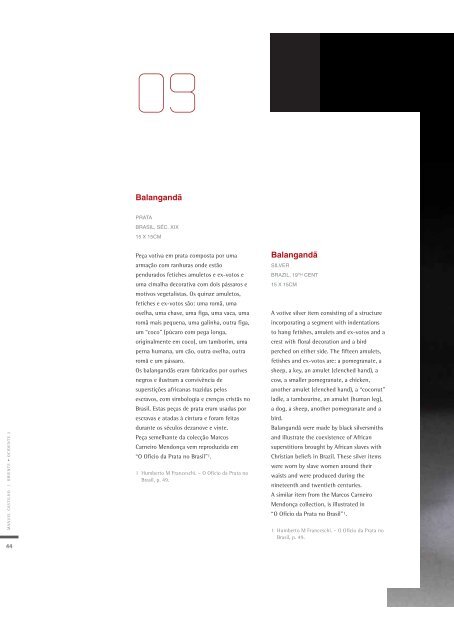ORIENTE OCIDENTE - Manuel Castilho Antiguidades
ORIENTE OCIDENTE - Manuel Castilho Antiguidades
ORIENTE OCIDENTE - Manuel Castilho Antiguidades
You also want an ePaper? Increase the reach of your titles
YUMPU automatically turns print PDFs into web optimized ePapers that Google loves.
MANUEL CASTILHO | <strong>ORIENTE</strong> • <strong>OCIDENTE</strong> 2<br />
44<br />
09<br />
Balangandã<br />
PRATA<br />
BRASIL, SÉC. XIX<br />
15 X 15CM<br />
Peça votiva em prata composta por uma<br />
armação com ranhuras onde estão<br />
pendurados fetiches amuletos e ex-votos e<br />
uma cimalha decorativa com dois pássaros e<br />
motivos vegetalistas. Os quinze amuletos,<br />
fetiches e ex-votos são: uma romã, uma<br />
ovelha, uma chave, uma figa, uma vaca, uma<br />
romã mais pequena, uma galinha, outra figa,<br />
um “coco” (púcaro com pega longa,<br />
originalmente em coco), um tamborim, uma<br />
perna humana, um cão, outra ovelha, outra<br />
romã e um pássaro.<br />
Os balangandãs eram fabricados por ourives<br />
negros e ilustram a convivência de<br />
superstições africanas trazidas pelos<br />
escravos, com simbologia e crenças cristãs no<br />
Brasil. Estas peças de prata eram usadas por<br />
escravas e atadas à cintura e foram feitas<br />
durante os séculos dezanove e vinte.<br />
Peça semelhante da colecção Marcos<br />
Carneiro Mendonça vem reproduzida em<br />
“O Ofício da Prata no Brasil” 1.<br />
1 Humberto M Franceschi. – O Ofício da Prata no<br />
Brasil, p. 49.<br />
Balangandã<br />
SILVER<br />
BRAZIL, 19TH CENT<br />
15 X 15CM<br />
A votive silver item consisting of a structure<br />
incorporating a segment with indentations<br />
to hang fetishes, amulets and ex-votos and a<br />
crest with floral decoration and a bird<br />
perched on either side. The fifteen amulets,<br />
fetishes and ex-votos are: a pomegranate, a<br />
sheep, a key, an amulet (clenched hand), a<br />
cow, a smaller pomegranate, a chicken,<br />
another amulet (clenched hand), a “coconut”<br />
ladle, a tambourine, an amulet (human leg),<br />
a dog, a sheep, another pomegranate and a<br />
bird.<br />
Balangandã were made by black silversmiths<br />
and illustrate the coexistence of African<br />
superstitions brought by African slaves with<br />
Christian beliefs in Brazil. These silver items<br />
were worn by slave women around their<br />
waists and were produced during the<br />
nineteenth and twentieth centuries.<br />
A similar item from the Marcos Carneiro<br />
Mendonça collection, is illustrated in<br />
“O Ofício da Prata no Brasil” 1.<br />
1 Humberto M Franceschi. – O Ofício da Prata no<br />
Brasil, p. 49.


